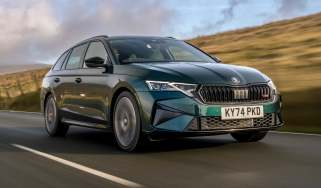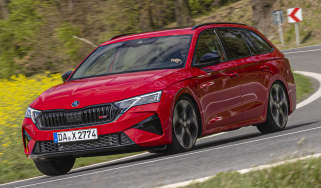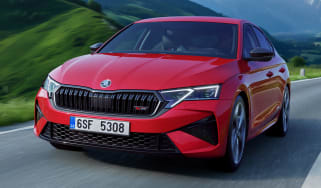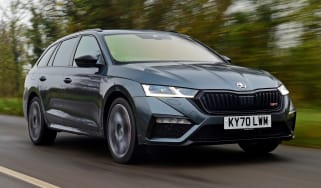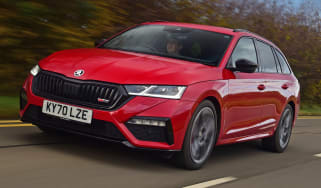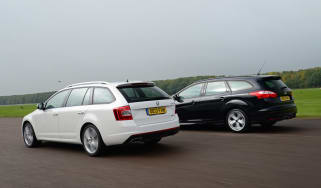Skoda Octavia vRS Estate review
What the Skoda Octavia vRS Estate lacks in performance, it makes up for in practicality and comfort


The Skoda Octavia vRS estate doesn’t have the heritage of the Volkswagen Golf GTI or Ford Focus ST, but Skoda’s vRS badge demands to be taken seriously. Promising a compelling blend of driving thrills and low bills, the brand’s raciest models have proven a big hit with British car buyers so far.
The latest addition to the line-up is this facelifted third-generation Skoda Octavia vRS, which promises to be Skoda’s fastest and most powerful car ever. And in roomy estate form, it’s one of the most practical, too.
Power comes from a gutsy 227bhp 2.0-litre turbocharged engine and you can choose from a manual or DSG automatic gearbox. You can also get the vRS with a diesel engine – the 181bhp 2.0-litre from the VW Golf GTD.
The Skoda Octavia vRS Estate is a great choice for those wanting to mix performance, refinement and practicality. This facelifted car has just 10bhp more than before, so it doesn’t feel any faster in the real world, but it didn’t need to - the Octavia is best at providing an enjoyable drive when you want one but settling back into family life when you don’t. It’s just as practical as before, and has more kit as well.
More reviews
Car group tests
- Volkswagen Golf vs Skoda Octavia: a battle for family hatchback supremacy
- Volkswagen Golf vs Skoda Octavia: 2023 twin test review
In-depth reviews
Road tests
- New Skoda Octavia vRS 2024 review: a fantastic and fast family car
- New Skoda Octavia 2024 facelift review: entry-level hatch is great value
- Skoda Octavia vRS (Mk1, 2000-2006) icon review
Used car tests
Engines, performance and drive
Fast estate cars have to be as fun to drive as they are practical – and the vRS certainly has the right ingredients to thrill. Under the bonnet is a 227bhp 2.0-litre turbo engine, plus there’s lowered and stiffened suspension, upgraded brakes and an XDS electronic differential.
The Skoda’s performance on a twisting back road is good, if a little disappointing. There’s no shortage of grip and the vRS always feels composed and agile; it’s just not as much fun as the Ford Focus ST estate.

You can use the Driving Mode Selection set-up to sharpen the throttle response and add weight to the steering, but none of the settings delivers as much feedback as you’d expect. And while the system also includes a Performance Sound Generator that serves up a more aggressive engine note when Sport is selected, it never sounds as good as the ST.
The Octavia’s efficient DSG gearbox also saps some driving enjoyment. In town, it’s hesitant when pulling away and jerky when moving through the lower gears. Keen drivers will prefer the precise six-speed manual.
What the Skoda lacks in driving fun, it makes up for with comfort. The ride is firm but never uncomfortable, while wind and road noise are both very well surpressed.
MPG, CO2 and Running Costs
If your head has as much say as your heart when buying a performance car, then the Skoda makes a lot of sense. The standard six-speed manual model will set you back a bit more than the entry-level Ford Focus ST, but it is cheaper than the ST-2 version.
The Octavia pulls further ahead when it comes to running costs, thanks to 149g/km CO2 emissions for the manual model. Fuel economy is 43.5mpg for the petrol and 61.4mpg for the diesel.
Better still, you can buy a three-year or 30,000-mile servicing plan for just £529. It’s not all good news, though: the Octavia has previously retained around 40 per cent of its value after three years, whereas the Ford holds on to a healthier 45 per cent.
Interior, design and technology
Like its predecessor, the latest Octavia vRS estate doesn’t shout about its status as a high-performance flagship. At a glance, it would be quite easy to mistake the newcomer for the humble 1.6-litre TDI version. However, look closely and you’ll spot a number of tell-tale signs that this Skoda is special.
At the front, there’s a slightly deeper bumper and a subtle vRS badge set into the grille, while moving around to the back of the car reveals twin-exit exhausts and a full-width reflector strip that runs across the bumper. The vRS also gets LED running lights, ultra-bright bi-xenon headlamps, mirrors and 18-inch alloy wheels.
It’s a similarly low-key story inside. There’s a pair of high-backed sports seats, unique graphics for the instruments and a chunky three-spoke steering wheel, but in all other respects, it looks like a standard Octavia.
That means a no-nonsense dashboard layout, decent-quality materials and robust construction. You get all the essential gadgets, too, including a Bluetooth connection, a DAB digital radio and climate control. The large touchscreen display is good-looking and functional, too.
Practicality, comfort and boot space
While the Skoda struggles to deliver driver thrills, it sets the benchmark for practicality. Star of the show is the vast 610-litre boot, which rivals models from the class above for carrying capacity. Not only is it big, it also features a wide opening and low loading lip. Lowering the 60:40 split-folding rear bench frees up a whopping 1,740 litres of space.
The load area is packed with useful hooks and cubbies, plus there are bright courtesy lights and a 12V power socket. On the downside, you have to pay £150 for the handy variable boot floor that comes as standard on cheaper Elegance models.
When it comes to passenger room, the Octavia also has space on its side. Occupants in the back get lots of legroom, while the flatter rear bench is more comfortable for three. There’s plenty of headroom, too, plus the Skoda’s larger side windows help create an airy feel.
Other highlights include the large glovebox, a huge storage box under the central armrest and deep, flock-lined door bins front and rear.
Reliability and Safety
Skoda has been a star of our Driver Power satisfaction surveys, and scored seventh place for the Octavia in 2016. Owners loved its reliability and quality, so expectations are very high.
Plus, the latest Octavia also has a strong safety record, having netted a five-star Euro NCAP crash test score. Seven airbags, stability control and post-collision braking all come as standard, while the vRS adds high-beam assist, lane-keeping assist and tyre-pressure monitoring.
